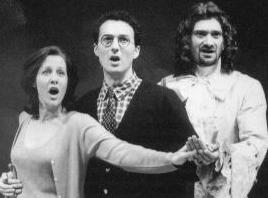SEARCH
CurtainUp
REVIEWS
FEATURES
NEWS (Etcetera)
ADDRESS BOOKS
Broadway
Off-Broadway
BOOKS and CDs
OTHER PLACES
Berkshires
London
Los Angeles
Philadelphia
Elsewhere
QUOTES
On TKTS
LETTERS TO EDITOR
FILM
LINKS
MISCELLANEOUS
Free Updates
Masthead
NYC Weather
A CurtainUp Review
Fermat's Last Tango

(l-r) Edwardyne Cowan,Chris Thompson, Jonathan Rabb
(Photo: Carol Rosegg) (Photo: ) |
When a Princeton professor named Andrew Wiles finally proved this puzzling theorem in 1990 he became that rarest of species, a mathematician who captured the public's imagination. If not quite as famous as another Princeton man, Albert Einstein, he was nevertheless a bona fide celebrity -- until a colleague reviewing his work found an error, or what mathematicians call a hole. A proof with a hole being as inauthentic as a bagel without one, Fermat's theorem was about to again sink into the archives of problems without solutions, leaving Wiles to obsess over patching that hole. Many months later, while sitting in his office, still studying that fatal error, he suddenly saw it.
It is Wiles' obsessive stick-to-itiveness that led the young musical team of Joanne Sydney Lessner (lyricist/librettist) and Joshua Rosenblum (composer/lyricist) to their own obsession -- the determination to translate Wiles' struggle into a musical to which everyone people who are intrigued by the way mathematicians work as well as those who couldn't care less could relate. Sure, they would have characters who were mathematicians and songs about numbers and proofs, but their aim was not to create a math lesson disguised as a musical, but something interesting, challenging and, above all, entertaining. The result of the Lessner-Rosenblum obsession is Fermat's Last Tango, proof positive that mathematics and music do mix, and without any major holes.
Given its genre, the musical which just opened the York Theatre Company's 32nd season, is more fantastical than the two Broadway hit plays, Copenhagen and Proof (the success of the latter is responsible for the current musical's switch from its original title, Proof). But the fantasy of bringing Fermat (Jonathan Rabb) back from the grave to joust with Professor Wiles' fictional alter ego, Daniel Keane (Chris Thompson), is an inspired bit of whimsy. The conceit of joining past and present is further extended with a quartet of performers in double roles: They are reporters who badger Keane during three press conferences which frame his triumph, humiliation and renewed triumph. They're also a chorus of dead mathematicians who emerge from their long stay in "The AfterMath" -- where else would you find the likes of Pythagoras (Mitchell Kantor), Gauss (Gilles Chiasson), Euclid (Christianne Tisdale) and Isaac Newton (Carrie Wilshusen)?
Lessner and Rosenblum haven't overlooked the fact that a musical without a love story is as flawed as a proof with a big fat hole. Consequently, in between Keane's contentious encounters with the foppish ghost of Fermat, his loving and much neglected wife Anna (Edwardyne Cowan) appears periodically to try to lure him out of his study and into her arms. Her initial failure prompts Ms. Cowan's biggest success, a show stopping song aptly entitled quot;Math Widow." This not being one of those grim operatic new musicals in which people not only don't live happily ever after, but often die, Anna not only succeeds but points the way to the solution Daniel has been struggling to find.
In the new music/new musical tradition, Fermat's Last Tango is almost entirely sung-through and some of the music, especially at the beginning, is operatic in flavor. This said, it is very much a fun show. The lyrics are catchy without unduly forced rhymes, and many of the twenty songs are melodic and work well with Janet Watson's musical staging. And yes, there really is a tango number, "I'll Always Be There," a triple triumph for Anna, Daniel and Fermat. Far from being a gratuitous song and dance to authenticate the title, Daniel's being flanked by his wife and his nemesis, is a most effective metaphor for his need to strike a balance between his obsession and his personal life.
Chris Thompson's Daniel is appropriately nerdy, but not so much that you can't see that he's also adorable. Most importantly, he has a thrillingly rich tenor. Jonathan Rabb is amusingly nasty as Fermat, and also has a strong baritone. The versatile double role players are effective whether badgering Daniel as reporters or quarreling amongst themselves in the "After Math."
Director Mel Marvin deftly guides the production along. The five musicians, who accompany but never drown out the singers, are smartly tucked out of sight behind a scrim at the side of the stage. The York's artistic director, James Morgan does the scenic design honors. As befits the small stage, he has kept things simple for all three locations: a conference hall, Keane's attic and Points Heavenward. Morgan's window for Daniel's atelier cleverly suggests both the attic location and a Pythagorian triangle.
If you don't expect a lot of production bells and whistles, and a score and lyrics that will restore the musical genre to its heyday, you could do a lot worse than this musicalized, fictionalized version of a fascinating event.
| FERMAT'S LAST TANGO
Book: Joanne Sydney Lessner Music: Joshua Rosenblum Lyrics: Joanne Sydney Lessner & Joshua Rosenblum Directed by Mel Marvin Musical director/pianist: Milton Granger (other musicians-- Chip Prince/keyboard, Nina Evinhuhov/violin, Ed Matthew/Woodwinds, Barbara Merjan/ Drums and Percussion Cast: Giles Chiasson, Edwardyne Cowan, Mitchell Kantor, Jonathan Rabb, Chris Thompson, Christianne Tisdale, Carrie Wilshusen Set Design: James Morgan Lighting Design: John Michael Deegan Costume Design: Lynn Bowling Sound Design: Running time: 90 minutes without intermission York Theatre Company/St Peter's Church, 619 Lexington Av (53rd/54th Sts), 239-6200 Tue - Sat at 8pm; Wed, Sat, Sun at 2:30pm -- $45 - $50 11/21/2000-12/31/2000; opens 12/06/ 2000 Reviewed by Elyse Sommer based on 12/02 performance |


